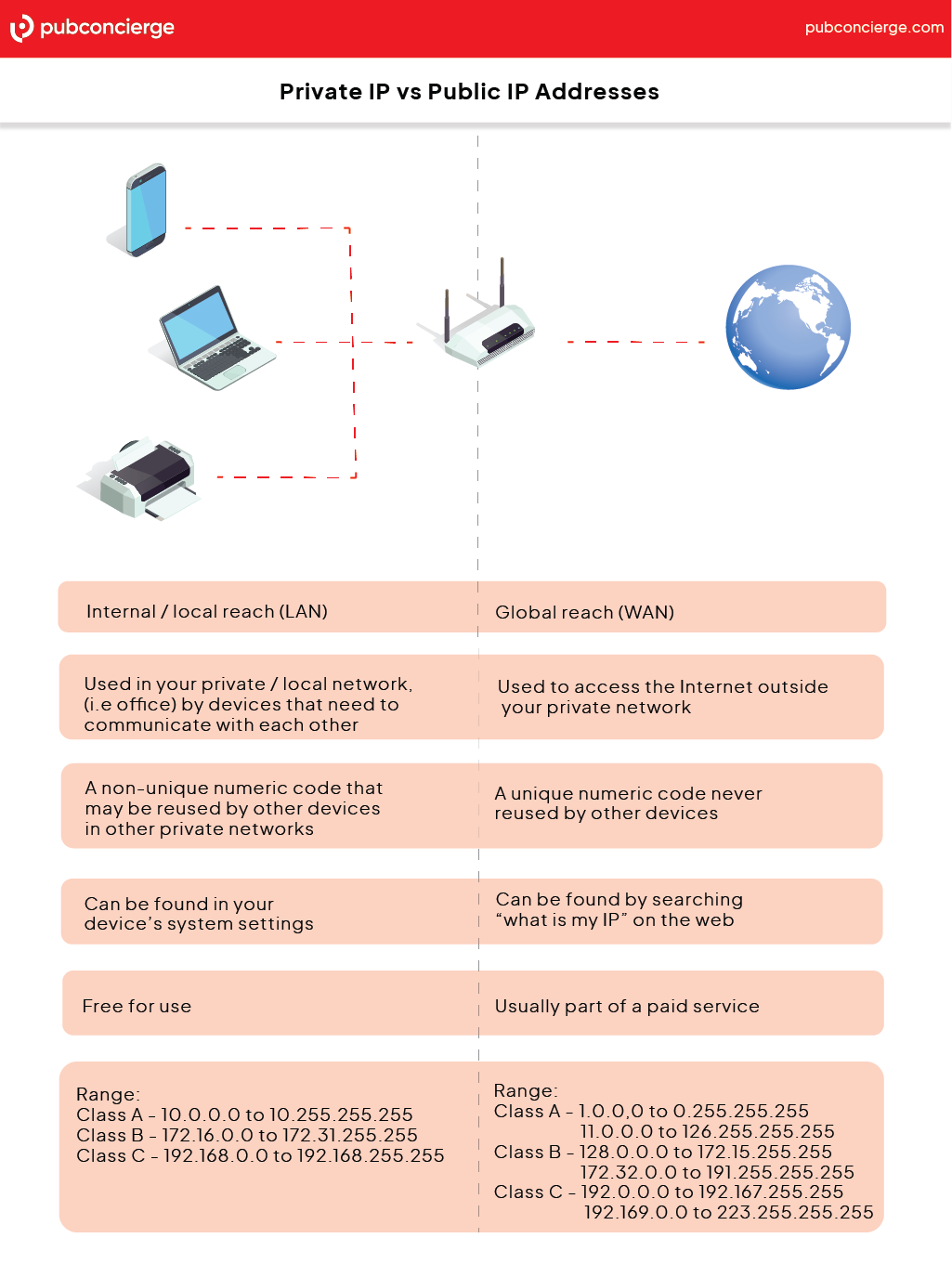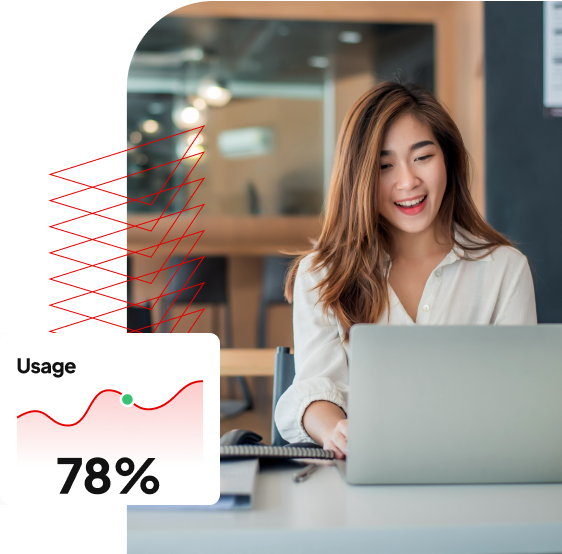IP addresses come in many forms and shapes. From dedicated static and rotating shared to public and private, IP addresses exist to serve a lot of different purposes. Today, we are going to take a look at the differences between public and private IP addresses, their respective characteristics and use cases in order to understand why they are viewed as two crucial parts in consolidating the identity of a device.
An IP address is an identifier for a computer or a device on a network. It is a unique identifier each device that wants to connect to the Internet must have. This is how the information you’re searching for knows where to find you. In turn, this shows why there are different types of IP addresses for different purposes.
Generally speaking, all IPv4 addresses can be divided into two major groups:
- Public IPs (also known as global or external IPs)
- Private IPs (also known as local or internal IPs)
Public IPv4 addresses can further be grouped under the term ‘WAN (Wide Area Network)’ addresses, meaning the IP addresses used on the Internet, whereas private IPv4 addresses are also known as ‘LAN (Local Area Network)’ addresses, since they are used on a local network.
What is a public IP and how does it work?
Public IPs are addresses used on the Internet. They can be accessed directly over the Internet and are assigned to your network router by RIR (Regional Internet Registry) or an IP broker. You can simply think of a public IP address as your home address. Therefore, a public address is visible on the Internet and essentially it is how your router communicates with the web.
This public IP address is assigned to you by RIR or an IP broker, making it the unique string of numbers your device needs in order to go online. Unlike private IPs, public addresses can be routed on the Internet.
If your router or computer operates on a public IP address, you gain access to a number of interesting benefits. For example, you can set up and manage your own server, or you can gain remote access to your own computer from anywhere on the global network.
Are public IP addresses visible online?
Yes, they are. Public IP addresses can be traced back to your Internet provider which in turn can reveal your general geographical location. Because of the exposed nature of a public IP address, it’s extremely easy to find your own IP address via search engines (i.e if you search “what is my ip” on Google).
Public IP addresses can also be used by websites to track your online activities and determine whether the same individual visits the same website multiple times. The results can help advertisers understand your browsing patterns and predict your preferences.
This is why many users choose to hide their public IP addresses through a security protocol, like a proxy server or a VPN service. They can quite differ from one another in terms of advantages and limitations, depending on your needs.
What is a private IP and how does it work?
By contrast, private (internal) addresses are not routed on the Internet, and no traffic can be sent to them from the Internet. Because of that, they work only on the internal/local network. In short, this is how devices connected to the same internal network connect and communicate with each other.
Therefore, devices that operate on the same local network are not required to connect to the entire Internet. Chances are your devices connect to a router in order to go online, be it via ethernet or Wi-Fi. To do that, the router needs to communicate with each device and assign a private IP address to each of them. However, this private IP address is visible only inside your network, meaning it cannot be found and traced on the Internet.
In terms of security, private IPs are a notable advantage, because they make it harder for an external host or user to establish a connection to your local network, like a home or an office network, and gain access to your device and/or data. Private IP addresses are located behind NAT (Network Address Translation)
Your private IP addresses help the router direct online traffic as well. The router needs to read your device’s private IP to know where to send the results you’re looking for.
How does LAN work?
LAN is short for “Local Area Network”. It is a network of computers within the same space, most common in working environments. Private networks can be much, much larger than a mere handful of devices connected to a router.
LAN can help companies set up a lot of devices to communicate with each other via private IP addresses. Each device with its unique assigned private IP connects to the Internet via LAN. The result is nobody outside the network can access it, but rather only employees and authorized personnel.
Are private IP addresses visible online?
In short, yes. However, based on what we discussed above, private IP addresses are traceable only by other devices on the same local network. Each device connected to your local network has a private IP address, and each device’s private IP address can be seen only by other devices within that network. But unlike the public IP your router uses to connect to the Internet, your private IP address cannot be visible online.
How are private IP addresses classified?
Private IP addresses are part of specific private IP ranges reserved by the Internet Assigned Numbers Authority (IANA). In fact, millions of private networks worldwide use reserved IP addresses within these three ranges, or subnets, as follows:
- Class A: 10.0.0.0–10.255.255.255 (a /8 mask)
- Class B: 172.16.0.0–172.31.255.255 (a /12 mask)
- Class C: 192.168.0.0–192.168.255.255 (a /16 mask)
The addresses in these ranges are intended for use in closed local area networks. Though they are not wide, they can be reused, since local networks all work independently from each other. Because of that, you might notice two or more devices you own having private IP addresses starting with 192.168. This is the most common default private IP address format assigned to network routers around the globe.
On the other hand, public IP addresses need to be unique. That’s why public ranges are much, much wider, as they include all the numbers that are not reserved for the private IP ranges.
Why are private IP addresses important?
It’s very likely you are already using a private IP address assigned to your device by your router. The router uses this private IP address to provide instructions or redirect the traffic from the Internet to the correct device.
In addition, private IP addresses help your devices communicate with each other over the local network, while your public IP address is responsible for you being able to access the Internet. Therefore, a private IP is an indispensable part of every network that uses a router. Even though private and public addresses are quite different, they work together to make your devices capable of accessing the web.
How to check which type of IPv4 address you are using?
As long as you are doing anything online, you are technically using both private and public IP addresses. Checking which type of address you are using is equally easy for both cases. For the public IP, you can simply Google “what is my IP address” and use a service or a website of your choice, such as this. If the result matches the IP address that your provider assigned you, then you have a public IP address.
To check your private IPv4 address, simply do the following:
- Go to Settings and click Network and Internet;
- Select Status on the left and click Properties;
- Scroll down to Properties to find your private IP address on the right of the IPv4 address.
It’s just as easy to look for your private IP address on Mac, iOS, and Android devices.

The most important differences between public IP addresses and private IP addresses
As we discussed above, public and private IPs are equally important for every device that wants to connect to the Internet via routers. However, their nature and purpose makes them different. The most important differences are related to how far they reach, and what they’re connected to.
A public IP address is used to access the worldwide network and identify you online, so all the information you are searching for can reach your device. A private IP address is used within a private network, or LAN, to connect securely to other devices within that same network.
While public IPs are visible and traceable online, private IPs cannot be identified online, thus consolidating the security of the local network. Furthermore, in terms of uniqueness, a public IP is unique globally, whereas a private IP address is unique only on the home network.
In addition, a public IP is assigned by your provider – RIR or an IP broker. On the other hand, a private IP is assigned by a network administrator. It should be also noted that private IPs are free to assign, use and manage, while there are usually costs associated with a public IP address, as part of a paid service offered by your provider. Companies use public IPs for data scraping, cyber security, SEO, social media or email marketing, among others. Companies can purchase IP addresses from IP brokers or can opt for more cost-efficient solutions, namely IP leasing services provided by suppliers like Pubconcierge.
Conclusion
Overall, you need both a public and a private IP address if you want to access the Internet. Both of them are an important part of this ecosystem and work hand in hand to let you go online and browse the web on different devices.
Private and public IPs complement each other. First, all the devices connected to the same router have a private IP that helps them communicate with each other. Secondly, whenever you connect to the Internet, you do so via a public (and visible online) IP address, which is a unique combination of numbers that makes communication between servers on the public Internet possible.






